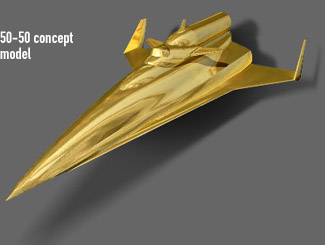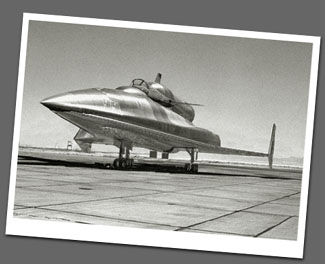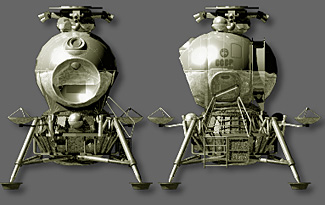 |
||
| For most of the second half
of the 20th century, a cold war raged between the world's two superpowers.
While battles were never fought on either country's land, plans were made
to take the war into the high frontier of outer space.
DEEP
COLD WEBSITE
|
||
From 1950 to 1980 the space race defined the furthest limits of the Coldwar. The short span of years from 1959 to 1969 saw the most significant advances in manned space technology and politics. Today, the International Space Station is the living legacy of the peaceful outcome of those days. But there is also a darker side
to the history of manned spaceflight: during those years, both the United
States and the Soviet Union planned to take warfare into orbit. Few of
these stories of the space race have ever come to light. And as the United
States is now moving towards re-establishing a significant military presence
in orbit, it is interesting to look back at that time... and wonder what
might have happened.
|
||
| Boeing Dyna-Soar
Dyna-Soar on surveillance mission (N/A) The Dyna-Soar was America's first manned spacecraft which actually reached the hardware stage. Conceived in 1957 as a logical next step after the X-15 rocket plane, the Dyna-Soar (originally designated X-20) was based on Eugen Sanger's WWII-era "Silver Bird" concept of a bomber which could skip around the globe on the upper atmosphere. The USAF saw the Dyna-Soar as their first step into the military use of outer space and planned numerous versions of the ship, including satellite inspection and electronic and photographic intelligence gathering (shown here). Later versions were also planned as mini-space stations and "orbital bombers" which could carry "stand-off" nuclear weapons into orbit. When the project was cancelled in 1963 with only one non-flying mock-up completed, the USAF's astronaut corps shifted into training for the Manned Orbiting Laboratory, or -- in the case of Dyna- Soar trainee Neil Armstrong -- to NASA's civilian projects. |
||
| Mikoyan MiG 105 Spiral & 50-50
Mikoyan MiG 105 Spiral & 50-50 Soviet rocket designers had also long been fascinated by the concepts of Eugen Sanger and sketched out many variations on the space-plane theme. In 1962 the Mikoyan Design Bureau formally presented it's "50-50" concept. The name came from the 2 components of the system: a hypersonic mothership aircraft and its single-seat orbital space-plane cargo. 
50-50 windtunnel model It was envisioned that the mothership would takeoff and when reaching 5.5 mach would release the spaceplane on a piggyback booster to attain orbit. While the mothership was never built, the Mig 105 Spiral (or "Lapot", meaning flat shoe) was constructed. It flew on at least 3 occassions after being airdropped from a Tupolev Tu-95 bomber. 
50-50 "photo" on ground Today the MiG 105 prototype sits in a muddy field at the Monino Soviet Air Museum outside Moscow. While 50-50 was never a good bet, the 105 design lived on in the BOR experimental shuttle and in the shape of NASA's HL-20 re-entry vehicle. |
||
| USAF Manned Orbiting Laboratory
USAF Manned Orbiting Laboratory On the same day in 1963 that Secretary of Defense Robert MacNamara cancelled Dyna-Soar, he formally re-committed to another USAF space project originally announced in 1960: the Manned Orbiting Laboratory, or MOL. Boosted aloft atop a Titan III booster and capped with a Gemini spacecraft, the Douglas-built MOL station would be able to support a crew of 2 during long duration military surveillance missions. But by 1967 - with unmanned Corona satellites effectively managing this task and military costs escalating in Vietnam - MOL was cancelled. These images show a projected KH-10 photographic surveillance station code named "Dorian" as it might have appeared in 1968-69. |
||
| Soyuz 7K-VI Zvezda
After his tremendous successes with Vostok and Voskhod, Chief Designer Sergei Korolyev turned his sights on the development of a ship capable of reaching the moon: Soyuz. He clearly understood that in order to secure funding he would need the support of the military and thus sketched out numerous ideas for military applications of Soyuz. In 1964 Korolyev's design nemesis Chelomei proposed the construction of an enormous military space station called Almaz (which ultimately became the basis of Mir). The Korolyev team took a more moderate approach and - being fully aware of the development of the US's military MOL - proposed a much smaller Zvezda (star) station based on a radically modified Soyuz. The proposal was accepted in 1965 and work commenced on Zvezda anticipating a flight in 1967. Zvezda would have been powered while in orbit by 2 plutonium radioisotope generators and had a rapid-fire gun for defense against killer-satellites. A advanced design called for a forward docking apparatus to allow docking with Almaz (shown above). Work on Zvezda was cancelled in 1967 with a single prototype in advanced stages of construction. |
||
| USAF McDonnell Blue Gemini
An integral component of MOL was to be the Gemini spacecraft. After the demise of Dyna-Soar, USAF astronauts began training to fly Gemini, and the Air Force planned to fly several missions in conjunction with NASA. These missions were called "Blue Gemini". Still believing that they would play a key role in manned space, the Air Force anticipated numerous military applications for their Gemini space craft - with or without MOL. It could be readily assumed that the USAF might develop on-orbit resupply missions utilizing Agena or Centaur-like docking targets. These images show a completely fictional on-orbit anti-satellite weapons system (ca. 1967) comprising a Blue Gemini ship and an armed OSP (Orbital Supply Platform). The OSP holds kinetic "space torpedoes" and provisions for extended missions. |
||
| LK "Luniy Korabl" Lunar Ship
For decades the Soviet Union denied that it ever raced against the US to put a man on the moon. It has only been in the last few years that Russian and Western experts have come forward with all the details of how the Soviets intended to get to the moon first - including prototypes of the secret spacecraft themselves.
The LK was the Soviet functional equivalent of the American Lunar Module, but with certain notable differences: the LK would have carried only a single Cosmonaut to the lunar surface and he would have had to "space walk" from the LOK (Lunar Orbiting Ship, approximately equivalent to the US Command Module) to the LK; the LK would have used the same engine for both final descent to the lunar surface and ascent back to orbit. In 1964, 3 years after Kennedy's pledge to get an American to the moon and back, the Soviet Central Committee of the Communist Party formally stated its objective of putting a man on the moon. As before, the driving force to make this happen was Korolyev. But he was too busy on planning his great N1 booster (on which the moon ships would be launched) to dedicate the time and energy to the actual design of those ships. The task of designing and building the LK went to the Yangel design bureau in the Ukraine. Initial plans called for the first launch of the N1 to be in 1966, and the first lunar landing as early as 1967, 2 years before the Americans. Work proceeded on the LK, but numerous engineering difficulties arose: the low payload weight available allowed for almost no reserve fuel, thus making landing potentially more difficult. This in turn lead to numerous studies of various landing and cosmonaut egress configurations. There were problems with the landing radar and blatant mistakes made which cost precious time. In the end, all these issues were apparently solved and several LK ships were built to various stages of completion. But all for naught: the N1 booster itself was never successfully launched and by the early 1970's -- as the Soviet will to get to the moon dried up -- the entire moon program was scrapped. |



